
Полная версия
Bible of the Time. …from the Big Bang to the present day…
The son of Ivan the Third, Basil the Third (also the Great), in a treaty with the emperor of the Holy Roman Empire, under the patronage of his mother, Sophia from the Byzantine dynasty of the Palaeologus, was first named as a king. In a marriage with Elena Glinskaya, the daughter of a prince leading a family from the temnik Mamai, Yuri and Ivan, the future Grozny, are born.
A week after the death of Basil the Great, the boyars kill Yuri, the main contender for the throne. Five years later, perhaps from the poison of the Shuiskys, the mother who took the reins dies. Another eleven years of the board of trustees, and Ivan the Fourth (1530 -1584) was crowned king in the Assumption Cathedral. The era of princes, equal only to princes and dukes in the European table of ranks, is generally coming to an end. The title is recognized by England and the Emperor of the Holy Roman Empire, but rejected by the Vatican, who in the thirteenth century conferred the title «Rex Russiae» on the prince of the lands of South Russia, Daniel Galitsky.
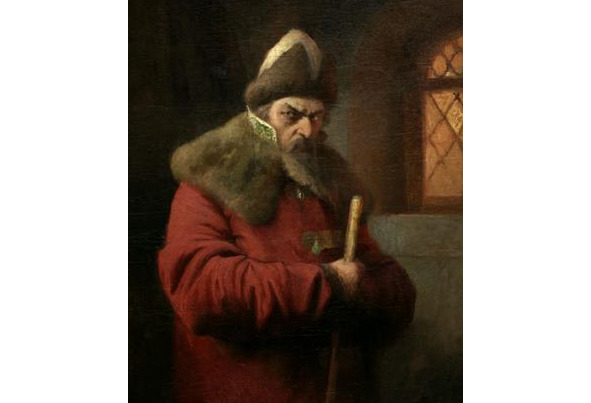
Ivan Vasilievich the Fourth (1530—1584). Art painting
Further events are as follows:
…The capture of Kazan, the destruction of the capital of the Golden Horde, eighty kilometers from modern Astrakhan, Saray-Berke. The beginning of the king’s mental degradation. Oprichnina and terror, over forty years of which, eight thousand people part with their lives (relatively few for that era by European standards).
Second half of the sixteenth century. Again – the invasion of the troops of the Crimean Khan, now Devlet Giray. Prior to that, in alliance with the Turkish sultan, the Tatars conquered the mountainous principality of Theodoro on the western coast of the peninsula, inhabited by 200 thousand Christians, and are fully prepared for large-scale conquests.
The suburbs of the capital are burned, except for the Kremlin and Kitai-gorod. A year later, the second campaign and the battle of Molodya, one hundred and fifty kilometers south of Moscow, will take place. Crimean Tatars and Turks are carrying out a disastrous frontal attack on the Russian «Gulyai-Gorod», made up of fortified wagons. The extermination of the 120-thousandth Turkish-Tatar army leads to the fact that the Crimean Khanate loses most of its male population. However, in order to avoid small raids, the Russian state still has to pay a «commemoration», a tribute, that is, after all, a tribute, until the very epoch of Peter the Great.
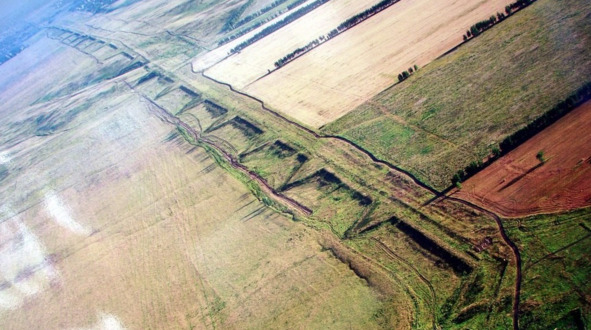
The Zavolzhsky shaft is located slightly east of Kazan and is an earthen embankment 8—9 meters high, with a moat 3 meters wide and deep, 2400 km long. Every 12 km. fortresses are located. It is not known exactly who built this gigantic structure. New settlers build their fortifications on top of the first. The first written records of such a construction appear in 1521.
Destruction of the oprichnina, which did not justify itself in the struggle against external enemies (1565 – 1572). The capture of Isker, the capital of the Siberian Khanate, in alliance with the free Cossack Ermak. The incorporation of the remains of the Jochi ulus into Russia. The capture of Polotsk in 1653 poses a threat to the Grand Duchy of Lithuania (despite the fact that life in the regions captured by the tsar is not getting better), and determines many not entirely pleasant consequences for Russia. This is a practical, and not just a written, creation of a union state – the Uniate and Catholic Polish-Lithuanian «Rzeczpospolita». King of Poland, Prince of Lithuania, formally a vassal of the Ottoman Empire, Stefan Batory conquers Polotsk, moves into the depths of Muscovite Rus. Here he gets bogged down in the siege of Pskov (1581—1582). About 16,000 defenders of the fortress oppose 50,000 besiegers. Huge traveling tours, large-caliber artillery, mines and mine galleries are in use. In the end, the Polish-Lithuanian-Swedish army loses 20—24,000 people and lifts the siege (the Yam-Zapolsky peace treaty is signed).
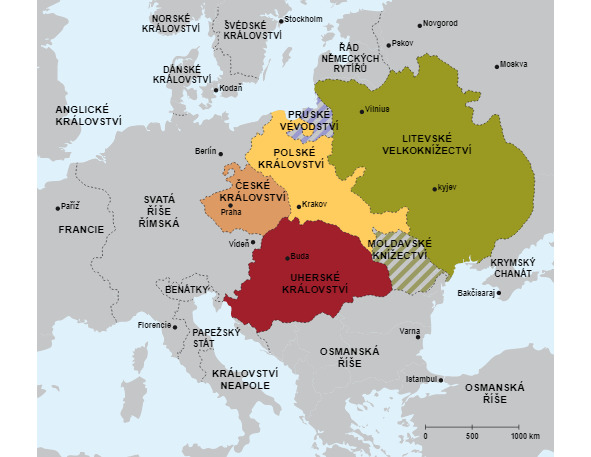
Jagiellonian Europe at the end of the 15th century. Poland and the Grand Duchy of Lithuania will soon become a single Rzeczpospolita. Ukraine – «Terra Nulius» for settlement
…For the last six years of his life, the tsar was unable to walk on his own due to a shameful illness and moved on a stretcher. Ivan the Fourth is treated for syphilis with the usual for the Middle Ages and the beginning of our days, mercury ointments.
Mercury is mixed with animal fat, sulfur and rubbed into the legs. Alternatively, general mercurization is carried out by placing the patient in a closed room with a bowl of heated mercury. If the person does not die, a positive result appears. Mercury is an antiseptic, and the causative agent of the disease, treptonema, is very sensitive to it.
Ivan the Terrible dies. On the throne, according to the decision of the Zemsky Sobor, the middle son Fyodor ascends, «a fasting man and a silent man, a saint on the throne.» He reigns for 14 years, establishes peace in the Russian land with endless prayers. In fact, his guardian, the well-born boyar Boris Godunov, rules. At forty years old (1598), the tsar dies, leaving no heirs and no written will. Seven years earlier, as a result of an accident, the youngest son of Grozny died from his seventh marriage, an illegitimate and not entitled to the throne, Tsarevich Dmitry. The dynasty of the main, Moscow branch of the Rurikovich is interrupted. Fyodor’s wife, Irina – Godunov’s sister, a week after her husband’s death, announces her desire to get a haircut in a monastery. Indeed, she leaves for the Novodevichy Convent, clearing the way for her brother to the throne. The beginning of Godunov’s reign is successful. However, the prayers of his predecessor are apparently lacking. In 1601—1603, after endless rains and early frosts that ruined the harvest, a severe famine began. The cost of grain rises a hundred times. Household gentlemen and abbots of monasteries keep it in barns, waiting for prices to rise. The tsar does not dare to order to put the bread on sale. Half a million people die.
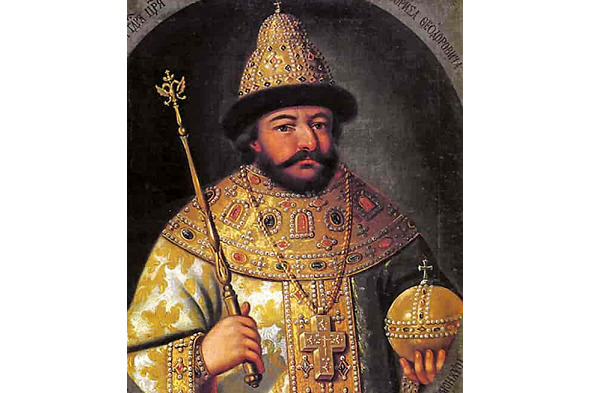
Boris Godunov (1551—1605)
In 1604, with a detachment of Cossacks and Poles (14,000 soldiers), False Dmitry the First began a campaign from Poland to Moscow. The government army under the leadership of Vasily Shuisky, three hundred cannons with competent artillerymen, archers trained in alternate shooting, defeat the impostor. Everything would be fine, but next year, after a plentiful meal, having examined Moscow from the tower, Godunov feels «faint» and «having lost his tongue» dies. His sixteen-year-old son Fyodor (the Second) became the king, with the regency of his mother, Maria Godunova (Skuratova), daughter of Ivan the Terrible’s attorney Malyuta Skuratov. The king does not have time to marry the kingdom. A considerable part of the army takes the oath to False Dmitry.
«The Chosen Tsar», that is, Godunov, and his successors, in the opinion of the people, is not equal to the tsar «hereditary, the ruler of God by the will, and not by human will.» For this reason, as well as the fact that the tsarist troops unleashed on the ground brutal repressions against the supporters of the impostor, Muscovites are opposed to a new, albeit a good ruler. Does not improve the image of Godunov junior, his grandfather’s ancestry from the executioner Malyuta Skuratov. After reigning for a month and a half, Fyodor and Maria Godunova perish at the hands of traitors («the people are silent»). Patriarch Job, an ally of a failed dynasty, is defrocked. His place is taken by Archbishop Ignatius of Ryazan. Ksenia Godunova, the sister of the unlucky monarch, is exiled to the monastery by the winners.
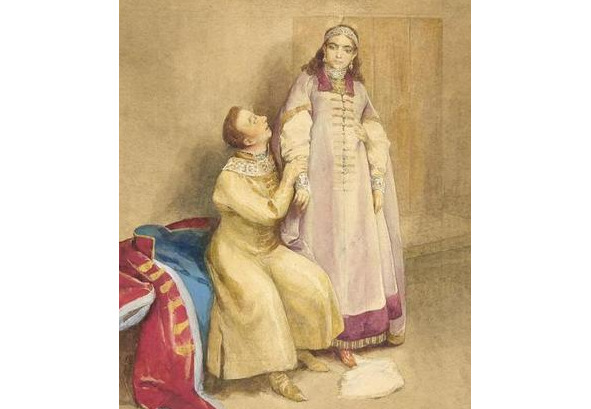
False Dmitry the First and Marina Mnishek. Art painting
So, in June 1605, False Dmitry the First, having coordinated the details with the Duma, solemnly enters the Kremlin and meets with Dmitry’s mother, Maria Naga. She recognizes the new anointed as a son, believably, with sobs, perhaps in order to leave the walls of the monastery. Henceforth, Dmitry calls the Duma the Senate, and himself – the emperor («Caesar»). In general, his rule is good for the country. Many boyars are returning from exile. The enslavement of the peasants is suspended. Taxes are going down, the economy is picking up. Obstacles to movement within the state and outside it are removed. The Polish king does not receive the promised Russian lands. At the same time, plans for a war with Turkey, the still ardent Crimean Tatar Crimea, a personal guard recruited from the Germans, as well as frivolous European orders are not popular among the masses.
All this would be quite bearable, but in the middle of May 1606 two thousand Poles came to the wedding of Dmitry and his beloved, the daughter of the Polish governor Marina Mniszek. During the festival, drunken hussars bully passers-by, break into houses, and attack women. This is used by the ambitious boyar Vasily Shuisky. He summons the people, ostensibly to protect the king. In the course of events, however, the action spills over into its opposite. Fleeing from the crowd, the wounded Dmitry Pervy falls into the hands of a detachment of archers of the external guard. They are confused for a while, then join the winning side. The guards send for Maria Naga. From the mouth of the arriving messenger comes something like; «Martha answered, her son was killed in Uglich.» False Dmitry The first is he, or Dmitry, we do not know this – he is dying. The body of the recently so revered monarch, with a pipe inserted in his mouth, is carried for three days tied to a cart around the city. This is not good. Many grieve openly. At the tomb of the king, people mark ominous signs. In the end, the confidants of the new ruler dig up the body of the unlucky king, burn it, mix the ashes with gunpowder and shoot towards Poland.
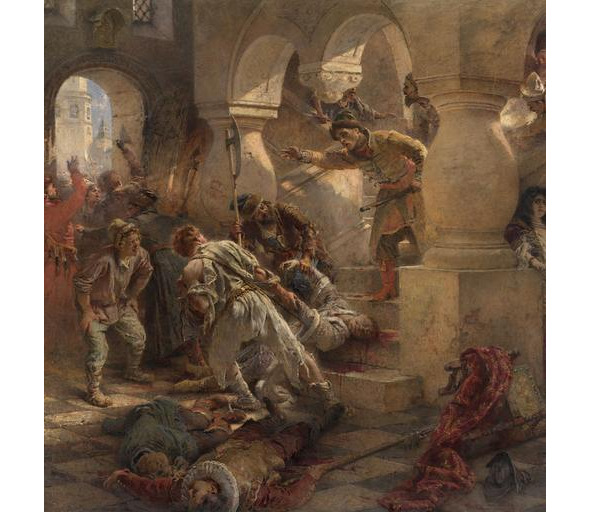
The death of Dmitry the First (1582—1606)
A crowd of adherents «cries out» Vasily Shuisky (the Suzdal branch of the Rurikovichs) king, and he becomes them. The Patriarch is replaced, from Ignatius to Hermogenes. An even less legitimate ruler will face severe trials from the very beginning. In October 1606, Moscow was besieged by the 100-thousandth army of the authorized representative of the next False Dmitry, galley rower, now the great voivode, Ivan Bolotnikov. A split is brewing in the camp of the rebels. Boyars and fugitive peasants are unable to form an alliance. Muscovites are ready to surrender. They only demand to show a figure only somewhat similar to a real tsarevich. But «voivode Dmitry» Ivan Bolotnikov does not have one at the moment. Mikhail Molchanov, one of the murders of Tsarevich Fyodor, a once confidant of False Dmitry the First, and, finally, an impostor, refuses to take part in the risky struggle personally. The storming of the capital, undertaken hastily in October, Bolotnikov fails. The army of the peasant leader, suffering defeat, retreats to Tula. Manages to recruit new forces, 40 thousand fighters, and carry out a second campaign against Moscow. A hundred kilometers southeast of the capital, near Kashira, in June 1607, a battle with the army of Tsar Basil the Fourth (Shuisky) takes place. The peasant rebels are well organized. They have effective artillery, they are one step away from victory. But, one of the commanders with a 4,000-strong detachment is cheating on Bolotnikov, striking the rear of the militia, sowing panic. The rebels scatter. However, many of the surviving militias are involved in the struggle of the parties, for or against the impostors of Dmitry II and III.
…The idea of Mikhail Molchanov with False Dmitry was correct for the army of Ivan Bolotnikov, but the search for a real person for this role dragged on. For some time, in Poland and Ukraine (the protectorate of Poland), the role of the prince was played by Molchanov himself. But, in Moscow they knew him too well. Only at the beginning of 1607, in Belarus, which was then part of the Polish-Lithuanian Commonwealth (the name of the Polish-Lithuanian state, tracing from Latin res publica – «Republic»), there is a person suitable for figure, age. In a halo of mystery, first as a relative of the tsar, Andrei Nagoy, False Dmitry II appears before the people at the end of the spring of 1607.
This False Dmitry does not have time for either the first or the second campaign of Bolotnikov against Moscow. He is late in Tula, where, on October 10, Shuisky’s troops, changing the direction of the river, forced the remnants of the peasant army to surrender. But, now 27 thousand people gather under his name. Poles, Don and Zaporozhye Cossacks, archers, nobles and fighting slaves wish to try their luck. False Dmitry wins several battles. Moscow, surrounded by stone walls (along the present Boulevard Ring), cannot be taken. Having camped in Tushino, False Dmitry blocks the capital. He manages to intercept Marina Mnishek, and, after some persuasion, marry her. Also, the «deputy tsar» manages to win over Metropolitan Filaret to his side. This priest becomes an understudy of the Moscow Patriarch. Dual power sets in. Shuisky and False Dmitry II (more precisely, Polish bodyguards who control their master) rule the country in parallel. Vasily the Fourth achieves some success with the help of the governor Skopin-Shuisky and the participation of Protestant Sweden, dissatisfied with the strengthening of Catholic Poland. Polish mercenaries openly show disdain for the Russian «tsarik». In the end, having climbed into the cart under the matting, False Dmitry goes to Kaluga.The spirit of the Bolotnikov uprising is still strong in this city. Only here the impostor begins to play an independent role, as if he is gaining a second wind. Remaining without a royal name, the Tushino camp loses its significance as the second Russian capital and is burned down. The Polish army is dispersed.
False Dmitry besieges Moscow with a new militia. An idea is ripening among the boyars-«shape-shifters». What if we remove both Vasily Shuisky and the impostor from the political field, and then the whole world choose a new tsar? In Moscow, the nobles really overthrow Basil the Fourth, forcibly shear the tsar into a monk and wait for retaliation from those close to False Dmitry. But they are in no hurry to fulfill this promise. After all, their positions are being remarkably strengthened. In order to fill the vacuum of power, the Seven Boyars elected the king of the Polish prince Vladislav Vaza, the eldest son of Sigismund III. Russian society is sharply polarized. The humiliated and insulted poor people, Cossacks and (Ukrainian) Cossacks, flock to False Dmitry, driven to Kaluga. The entourage of Vladislav Vaza, more precisely, his representatives in Russia, are replenished by nobles.
Outside the hierarchy, too homogeneous masses of the people come under the power of instincts. The concept of justice, as such, ceases to exist. The wheel of terror spins towards all suspicious persons. Moreover, False Dmitry expects to call on the Crimean and Nogai (Astrakhan) Tatars who are already moving to Central Russia to march on Moscow, in order to immediately improve all their affairs. But, his plans are not destined to come true. In revenge for one of the victims of the terror, the impostor is killed by his own bodyguard.
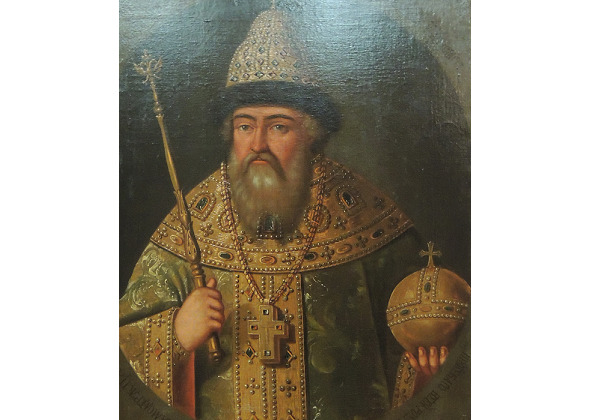
Vasily the Fourth (Shuisky), 1552—1612, the last representative of the Rurikids on the throne. According to the testimony of contemporaries, in life he is not so good-looking. The tsar dies in Polish captivity at the same time as his brother Dmitry, also a prisoner and heir.
So, Vasily Shuisky is forcibly tonsured into a monk. Together with two brothers, he is kept in a castle near Warsaw. The former monarch has no children of his own. The three-year-old son of Maria Mnishek, Ivan, can claim the throne. Still, the prince is still too young. Tsar Vladislav is not popular among the people. In addition, he does not risk personally leaving Poland for Moscow and seems to be cooling off to the idea of becoming the ruler of Russia. The soil for the emergence of the third False Dmitry is still fertile.
And the impostor is declared, in January 1611, in Ivangorod besieged by the Swedes (150 kilometers west of the place where St. Petersburg will be). False Dmitry III manages to gather a militia in Pskov and even drive off the conquerors. However, having come to power, the impostor hesitates to advance to Moscow. He embarks on a dissolute life, commits violence and imperceptibly loses popularity. The conspirators removed the Cossacks loyal to him from Pskov, ostensibly to fight the Swedes who besieged the suburbs. False Dmitry senses something is wrong and tries to escape. They catch him, put him in a cage and take him to Moscow. The impostor is killed on the way or executed in the capital.
Moscow, meanwhile, is occupied by the Poles. After all, nominally the king is fifteen-year-old Vladislav Vaza. He is elected but not crowned. Patriarch Hermogenes (number one), initially loyal to the foreign ruler, realizing the plans of the gentry, frees the people from the oath. Hermogenes’ letters resonate primarily in Ryazan, where the people’s militia is already being formed. The Poles send Cossacks of Little Russia to destroy the Ryazan cities. One part of the registry perishes, the other takes the side of the people. Meanwhile, Nizhny Novgorod is also rising to the fight. In mid-March 1611, two militias unite near Moscow. There are a hundred thousand of them in total. The occupation forces number 5,000 Poles and 2,000 Germans. They carry out repressions in the city, set fire to houses in order to cope with the indignant people even before the start of the assault. Fire and steel kill seven thousand townspeople. Boyars and slaves dependent on them are in alliance with the Poles.
The militia does not dare to storm the white-stone walls. It creates its own Zemsky Sobor and a system of state power. However, between the two forces – the nobility, seeking to restore serfdom and the Cossacks, who want to keep their liberties, discord arises. The Poles use this. Their forged letters indicate that the Ryazan leader of the Lyapunov militia is determined to destroy the Cossacks. The Cossacks summon Lyapunov «to the circle», where they kill without trial or trial. As a result, most of the nobles leave the camp. Dying in the dungeon of the Chudov Monastery, Patriarch Hermogenes calls on the people to no longer obey the governors of the Moscow region D. Trubetskoy and I. Zarutsky. However, the archimandrite of the influential Trinity-Sergius Monastery, Dionysius, advocates rallying under their leadership. A large Cossack detachment remains at the siege of Moscow until the middle of the summer of 1612. When the units of the Second Militia approach, it leaves for Astrakhan and does not participate in further hostilities with the interventionists. Zarutsky has an important trump card – Marina Mnishek with the son of False Dmitry II. The ataman wishes to use it for his own purposes. At the walls of the capital, Trubetskoy’s forces remain, who were not directly involved in the murder of Lyapunov.
…The Second Militia is gathering in Nizhny Novgorod. It is based on the alliance of the representative of the nobility – Prince Pozharsky and the peasantry – the head Minin. A public treasury is created from voluntary donations. She generously pays for the help of experienced service people. In September 1612, after the deposition of False Dmitry III, it was possible to recapture the supply train for the besieged. Part of Moscow and Kitai-Gorod were freed from the gentry. What remains is the Kremlin, within whose walls Poles and Russian boyar families are already practicing cannibalism everywhere. By placing a regiment at its walls, Pozharsky protects the boyars and one of the two Polish detachments from lynching the surrendering prisoners. The second formation of the Polish-Lithuanian garrison falls into the possession of Trubetskoy’s Cossacks and completely perishes. The troops of Minin and Pozharsky enter the Kremlin on November 6, 1612. A solemn prayer service is held at the Execution Ground. The new Polish army, halfway to Moscow, stops at Volokolamsk.
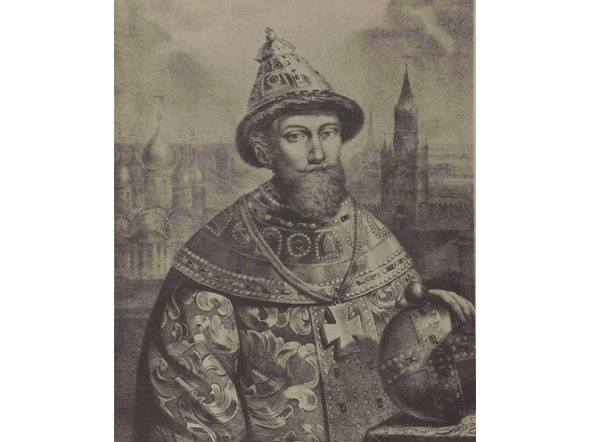
Mikhail Fedorovich, 1596—1645, the first monarch from the Romanov dynasty. He dies, as a contemporary testifies, from melancholy, «that is, torpor» and «a lot of sitting.» The four children he earned in marriage with his unloved, or at least not chosen by him Evdokia Streshneva, continue the dynasty.
In January 1613, an all-estate meeting, the Zemsky Sobor, was convened. The goal is to elect a new king. Among the applicants are Pozharsky, Trubetskoy, the Swedish prince Karl Philip, Vladislav Vaza and Ivan, the son of Maria Mnishek. The fate of this child is sad. In 1615, he was transported from Astrakhan to the capital, where he was executed along with the ataman Zarutsky.
The election is won by the son of Patriarch Filaret, Mikhail Fedorovich Romanov. Patriarchs are not supposed to have children, but Fyodor Romanov and his wife Xenia did not always have a monastic rank. They had to go to a monastery under Boris Godunov, but by that time they already had a son, Mikhail. In 1611, Filaret became the «named» patriarch in the Tushino camp, in parallel with Hermogenes staying in Moscow. Then the Poles take him to Poland, but there he also finds ways to communicate with the Zemsky Sobor.
So, to Mikhail Fedorovich and his mother, who are hiding from the persecution of the Poles in the Ipatiev Monastery (Kostroma), the embassy of the Zemsky Cathedral arrives and reports important news. The young man becomes the first king of the Romanov dynasty.
Three years later, Polish troops, together with the Cossacks of the gentry Pyotr Konashevich (Sagaidachny), are trying to restore Vladislav Vaza to the rights of king, storm Moscow, but unsuccessfully. Nevertheless, according to the Treaty of Deulina, concluded in 1618, Russia is losing 26 cities. Among them are Smolensk, Chernigov and Putivl, together with the population, except for the clergy and nobility, who are allowed to move to the Russian lands.
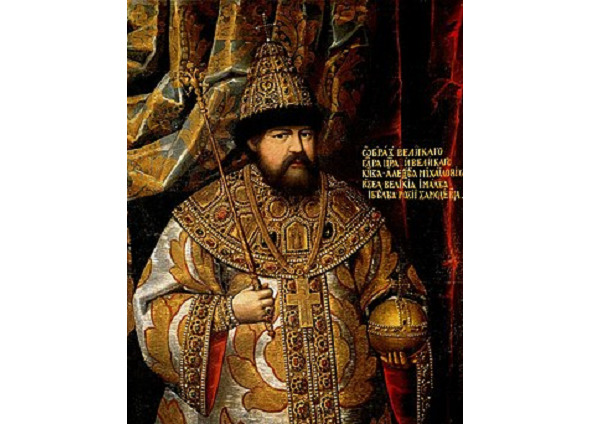
Alexei Mikhailovich (1629—1676), tsar, father of Peter the Great. A monarch of a good-natured disposition, peacefully combining Russian and Western orders, keen on astrology and European music, the founder of the «new order» regiments – Reitars, soldiers, dragoons and hussars.
Vladislav Vaza still claims the Russian throne.
Mikhail the First is going to get married and, examining the line of brides, chooses Maria Khlopova. The girl does not like the queen mother. At her instigation, doctors conclude that «Maria Khlopova is fragile to the royal joy.» Other doctors come to a different conclusion, however, the last word is for the nun. Some time later, with the assistance of his father, who returned from Polish captivity, Mikhail almost marries Khlopova, but his mother’s influence outweighs. In the end, the tsar enters into an alliance with Evdokia Streshneva, the confidante of one of the boyars who came to the bride. The marriage is happy, except for the fact that, even with royal care, six out of ten children die before reaching adulthood (the usual statistics of that time).
In 1636 Michael declares war on Poland. Russian troops besiege Smolensk. The governors return to Moscow with 8 thousand soldiers, the initial number being 32 thousand. The state of affairs remains. The only plus is that the King of Poland, Vladislav, renounces his claims to the Russian throne.
In 1645, Mikhail’s son, Alexei Mikhailovich (Quietest), became tsar. During his reign, the reunification of Ukraine and Russia, the Copper and Salt riots and the church schism took place. The church council of 1666 supports the reform of the high priest Nikon, anathematizes the Old Believers and, regardless of all that, condemns the patriarch to imprisonment in a monastery. Open resistance to the new religious charter lasted until the capture of the Solovetsky monastery by the troops in 1676. In 1654, in connection with the annexation of Ukraine, a new Russian-Polish war began. The combined troops of Buturlin and Khmelnitsky are making progress. They are already fighting on the territory of ethnic Poland and Lithuania. The entry into the war of a strong player, Sweden, which snatched Warsaw and Krakow from the hands of Russia, forces the parties to the conflict to sign the Vilna truce. Nevertheless, there is an interesting prospect for the election of Alexei Mikhailovich to the Polish throne.




